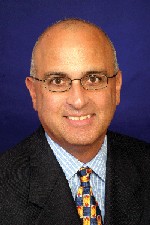 |
Q: When I prescribe Pred Forte (prednisolone acetate 1%, Allergan), I want the patient to have the brand name product, not the generic. I always sign on the Dispense as Written line on the Rx, but the pharmacist often still dispenses the generic drug. When I call him, hes abrupt with me. How can I get through to this guy?
A: Walk a mile in the pharmacists shoes, says optometrist and registered pharmacist Jill Autry, of Houston. That wont take long. Pharmacists are on their feet all day, often working 12-hour shifts, sometimes without a break, she says.
Pharmacists are overworked and underappreciated, Dr. Autry says. Due to a change in their educational requirements (a six- to eight-year doctorate program is now the norm), pharmacists are in short supply, she says. Yet these highly educated professionals generally work in high-pressure, low-respect retail drug storeswith a phone to one ear and a crabby customer in the other.
They usually have no limit on the amount of work they are required to perform. Some may need to fill 200 prescriptions a day, while others must fill 500 a day.
 |
|
Pharmacists are a prime resource for information on newly approved drugs. They also can provide calculations for dosing adjustments for children and special patients. |
Is it any wonder that the pharmacist might overlook that you signed on the Dispense as Written line? says Dr. Autry, who worked as a retail pharmacist and as a hospital pharmacist before going to optometry school.
Or, maybe youre not up to date on the Rx requirements in your state. In Texas and many other states, your signature on the Dispense as Written line is no longer good enough, Dr. Autry says. For a pharmacist to dispense a brand-name drug, the prescriber must hand write Brand Name Medically Necessary on the prescription. Some insurance plans have the same requirement.
Medicaid is the notable exception. Even if the prescriber properly requests a brand-name drug, the pharmacist is required to replace it with the generic equivalent in most instances, Dr. Autry says. Then youll have to make the decision whether to give the patient a sample if there is a clinical need or to switch the patient to another drug, she says.
To get the service you want for yourself and your patients, Dr. Autry recommends these steps to improve communication between you and the pharmacist.
Get friendly. If you dont know your nearby pharmacists on a first-name basis, call them and introduce yourself. Treat them as fellow health professionals who deserve respect. Realize that they not only work hard, but they give away most of their knowledge for free. You can go into almost any pharmacy at any timemany of them are open 24 hours a day nowand get very good advice about medications, Dr. Autry says. Not many professionals provide that kind of help with that kind of availability.
Work together. Many pharmacies have public health events such as diabetic screenings. Call the pharmacist and offer to set up a glaucoma screening at the same time. This kind of coordination not only benefits your relationship with the pharmacist, but it also really benefits the community, Dr. Autry says.
In addition, pharmacists are a prime resource for information on newly approved drugs, and they can provide calculations for dosing adjustments for children and for other special instances. Most pharmacists are happy to provide this kind of information, Dr. Autry says.
Contact a compounder. Few pharmacists have the time to compound unique preparations, or the interest in doing so. Those pharmacists who do compound eye drops must have sterile conditions and uncommon ingredients, Dr. Autry says. They tend to operate small, independent drug stores and are generally more open to putting on events such as screenings, she says, so theyre good people to know. (To find one near you, go to the Web site of the International Academy of Compounding Pharmacists, http://www.iacprx.org/referral_service/index.html)
Write neat and complete. As many as 1.4% to 15% of all prescriptions are illegible.1,2 Meet your pharmacist halfway and write the drug information clearly, Dr. Autry says. And dont forget to provide all the other pertinent information, such as your contact information (including a phone number to reach you in person after hours) and your DEA number if writing for a controlled substance.
Q: I dont have a DEA number, but I also never prescribe controlled medications. Why do some pharmacists call up and insist on a DEA number even for a non-scheduled medication like a glaucoma drug or antibiotic?
A: Insurance companies track prescriptions by the prescribers DEA number, Dr. Autry says. So the pharmacists computer may reject a prescription without a DEA number. Its not the pharmacists fault. His or her hands are tied.
If you have a DEA number, give it to the pharmacist when he or she calls, even if its for an Rx thats not a controlled substance, Dr. Autry says. If you dont have a DEA number, tell this to the pharmacist, who can then call the insurance company and explain the situation.
In short, Dr. Autry says, if you get to know your local pharmacists better, youll save yourself time and get better care for your patients.
1. Gupta AK, Cooper EA, Feldman SR, et al. Analysis of factors associated with increased prescription illegibility: results from the National Ambulatory Medical Care Survey, 1990-1998. Am J Manag Care 2003 Aug;9(8):548-52.
2. Meyer TA. Improving the quality of the order-writing process for inpatient orders and outpatient prescriptions. Am J Health Syst Pharm 2000 Dec 15;57 Suppl 4:S18-22.

